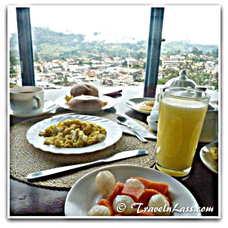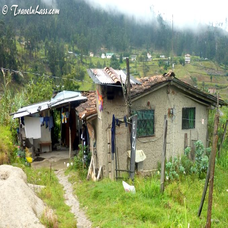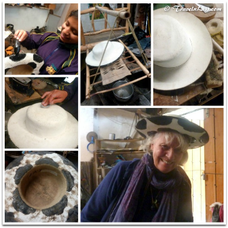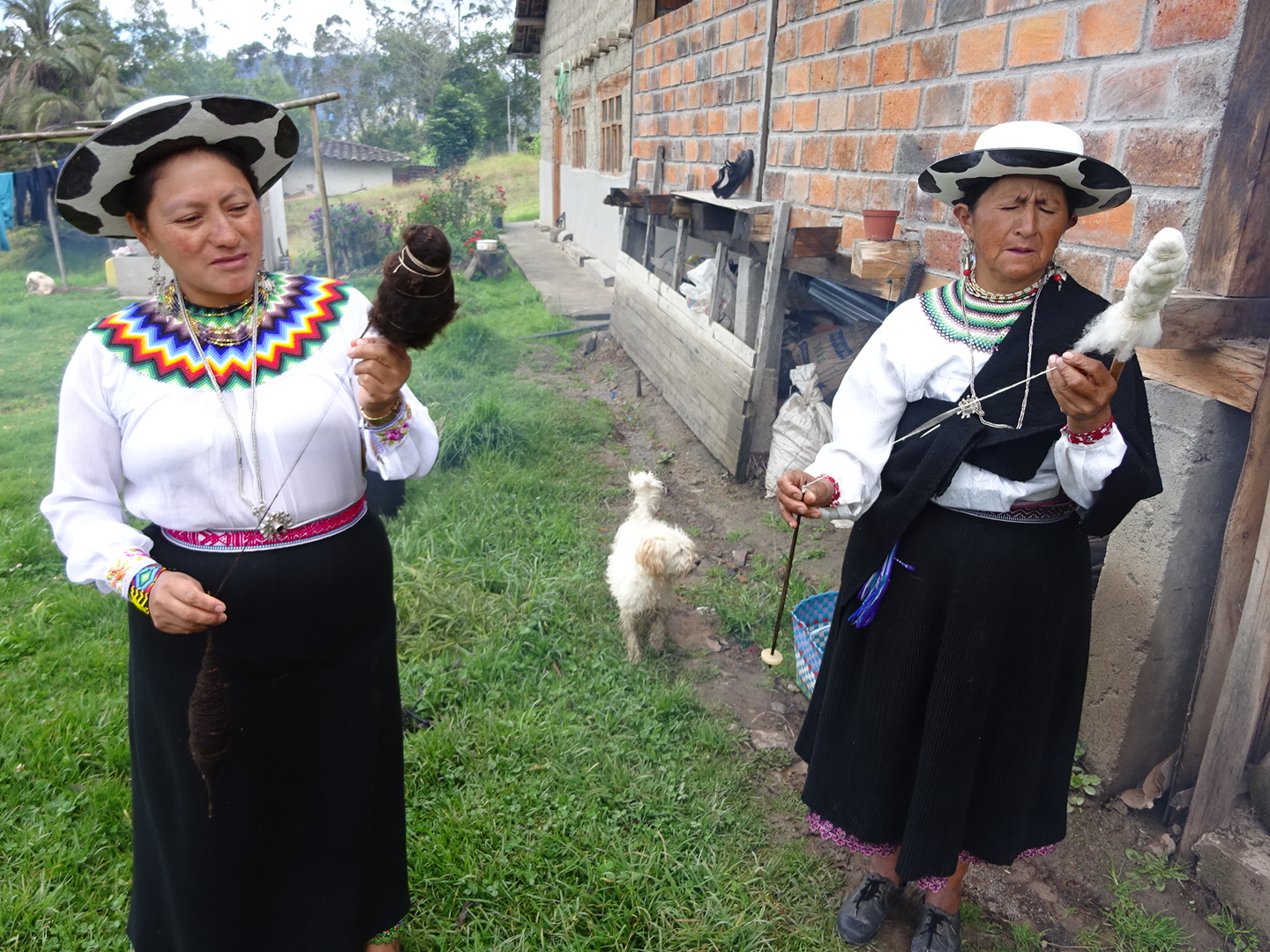[color-box color= “gray”]Visit Charming Saraguro, Ecuador through the eyes of TravelnLass Dyanne Kruger as she explores the nearby Cuenca town in search of its famous and strange “cow-spot”hats. [/color-box]
Normally, I am nothing if not an avid explorer. Drop me anywhere on the planet and I’ll immediately take off at a sprint. I like nothing better than to explore some new corner of the globe. Indeed, I’m now pushing 40 different countries visited and no less than 5 foreign lands I’ve called “home”.
But since I arrived here in the (stunningly picturesque, it must be said) Andean town of Cuenca more than a year ago, I’ve been uncharacteristically content to stay put. Indeed, I’ve hardly ventured beyond the cobbled streets of El Centro.
For a while, I was a bit concerned that perhaps I’d lost my travel mojo, so content that I feared my backpacking days were over. Ah, but I’m happy to report that the stifling (if comfy) veil of inertness has finally lifted. I’m now eager to sample the wide diversity of Ecuadorian corners that lay both near and far from my front door. In January, I headed to those legendary islands off the Ecuadorian coast for an 11-day DIY adventure–the Galápagos of course. And just recently I discovered a most amazing destination much closer to home. This is the tale of my mini-adventure to Saraguro.
The Quest for Cow-Spots
Saraguro first bleeped across my radar screen thanks to an image someone posted in the Ecuador Expat forums on Facebook just weeks after I’d first arrived in Cuenca. All I recall is that the photo showed a festival with folks wearing the most extraordinary white hats painted with-–of all things-–black COW SPOTS on the brims. Right then and there, I decided I simply HAD to attend the annual Pawkar Raymi festival in Saraguro the following year, and see these remarkable hats for myself.
And so it was that I set off on a Friday morning in late March, heading to the village of Saraguro-a mountain hamlet so tiny it doesn’t even merit a full destination stop on the local bus schedule. As I’d of course never been there, I didn’t have a clue as to what I might find, nor if the Pawkar Raymi festival would be worth the trip. But that’s precisely what attracted me in the first place: the curiosity, the not knowing, the unknown.
Visit Charming Saraguro Ecuador
Cozy Sleeps
I’d heard that Saraguro was situated along the road to Loja so I hopped on a bus (just $2.50 with my 50% tercera edad discount) for the three-hour trip. Upon arriving in Saraguro, it was easy enough to find a bright yellow taxi to take me up to my (prebooked on bookings.com) hostal: Achik Wasi. Located on a hill overlooking Saraguro, the guesthouse ($25/nt.) is utterly charming and supremely tranquil. A 10-minute stroll will take you to the heart of the town, though a $1 taxi in lieu of puffing your way back up (at 8,000+ feet) on your return to Achik Wasi is recommended.
With my sleeps happily squared away, I headed down the hill to check out the cobbled streets, the cathedral, and the town square. Snapping photos along the way, I popped into bakeries and local tiendas selling fresh, homemade cheese rounds and bid cheerful “¿Cómo están?”s to clusters of locals dressed in traditional black woolens (the women in long pleated skirts, the men in trousers–both with a single, long plaited braid topped by either a black felt fedora, or else the distinctive white felted hat painted with “cow” spots). Dinner Friday night was my favorite street-eat: a paper bowl of ceviche (a whole dollar!)

Delish Eats
Following a full (gratis) breakfast at Achik Wasi with a stunning view of the town below, the next morning I again strolled down the hill to enjoy the Pawkar Raymi festivities. A joyous celebration of the bountiful provisions from “Pacha Mama”, or Mother Earth, the word “pawkar” means “blossoming”, and “raymi” means ritual (CLICK HERE for details and pics from my visit to the 2015 Pawkar Raymi Festival).
After the parade and the festival ceremonies, I ambled over to one of the most remarkable bits of serendipity of my Saraguro visit: the ShamuiCo Espai Gastronomic restaurant, located on the town square next to the cathedral. A Peace Corps volunteer living in Saraguro had recommended I try the local chicha there–a lightly alcoholic beverage (think wine spritzer) made from maize. Turns out they offered a choice of four different flavors of chicha so I (of course) sampled each and every one over the course of my Saraguro visit.
A Happy Coincidence
I bumped into a trio of expat chums from Cuenca that were already settled in sharinga paella ($9 with enough to serve the 4 of us plus a couple of side dishes at $3.50 each). I added another side dish to the order, and my new companions were happy to help me taste-test 3 of the chichas on the menu. The verdict? The .50 plain Chicha La Podrida turned out to taste merely of fruit juice (i.e. little fermentation and no “sparkly” fizz), the Chicha Clarita ($1) proved fizzy and citrus-y, and the Chicha Oscurita (also $1 and my fave!) a darker, stronger version of the Clarita (think: light vs. dark lager beer).
Apparently the chef of ShamuiCo had previously worked at several 5-star restaurants in Barcelona, as is evident from the upscale fusion dishes on the menu, as well as the artistic presentation. Indeed, the menu included so many intriguing options (ranging from $2-$8 for generous tapas to full entrees), I simply HAD to return to ShamuiCo for dinner that night. In addition to THE most decadent dessert, aptly dubbed Chocolates en Texturas (all manner of chocolate textures, including chocolate ice cream, dense brownies and truffles, topped with thin chocolate wafers), I was able to finalize my chicha sampling with the best chicha of all: Chicha La Huevona (essentially the sparkling Clarita version whipped frothy with an egg).
But What About those Cow-Spots?
Ah, but the festival and the chicha and the delectable food wasn’t the main quarry in my quest to visit Saraguro. I was still obsessed with tracking down the source of those intriguing “cow spot” sombreros.
There were a few for sale in the handful of tourist tiendas along the town square, so I was able to finally hold one in my hand and marvel at its (surprisingly) ceramic-like felted wool lacquered surface and its considerable heft. Not a cozy little knitted number meant to keep your ears warm, no siree. These hummers were hard as bricks, and easily as heavy. Stiff and hard as rocks (not to mention $70 apiece), I surely wasn’t about to tuck one into my backpack and carry it home. Still, I was curious how and who made these unique doorstops.
When I asked several of the townfolk where I might find the place where the hats were made, all I could elicit was a single name: Frederico. Inquiring further at my guesthouse, I learned that the hats were made in a small village near Saraguro, about 15 minutes away by taxi. Once again, I knew not what I would find there, nor where exactly the mysterious Frederico might be located, but I was clearly hot on the trail now, and nothing would do but to hop in a taxi and head out into my favorite corner in all the world…
“The Unknown”

Veering off the highway onto a muddy dirt road that wound up, and up, and up, my taxi driver finally stopped in front of a most ramshackle little house, and simply mumbled “Frederico”. Confused, I stumbled out of the taxi, and gawked at what had to be the world’s tiniest and most forlorn corporate headquarters: a humble shack of a house with a carved wooden sign that read: “Confección y arreglo de:” (Manufacture and repair of:) plus… a picture of a cow-spotted hat.
–Apparently, “Frederico” is the ONLY maker of these unique, felted wool hats worn exclusively by the indigenous Saraguro community. And though Fred was out for the afternoon, his daughter was kind enough to show me around his tiny workshop. Carefully tip-toeing around the cluttered and dusty room, it was fascinating to see for myself the hat-making process—from bowlfuls of raw sheep’s wool, to matting and pressing into floppy hat shapes, to steaming and drying the shaped hats over a simple wood stove. Then trimming the brims, followed by repeated painting (with a maize-based paint) and sanding (which renders the hats waterproof), to swabbing the edges with tar to complete the waterproofing process. And finally applying those distinctive cow-spots on each and every brim.

Needless to say, finally locating the one and only source of these curious hats was the highlight of a most delightful visit to the obscure little hamlet of Saraguro.
Like this article? DO share it on Twitter or Facebook by clicking on the share button below. Better yet – subscribe to my TravelnLass blog so you never miss a post. I’ll also send you my 30 Best Travel Tips gleaned from 30+ years and 40 countries of solo travel: CLICK HERE to Subscribe

















